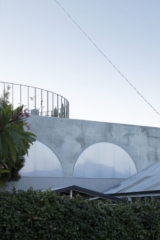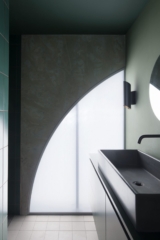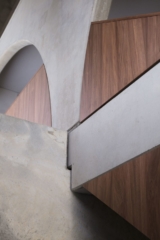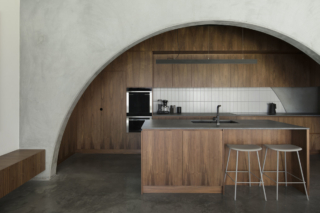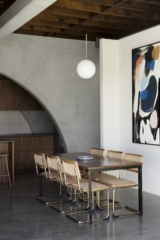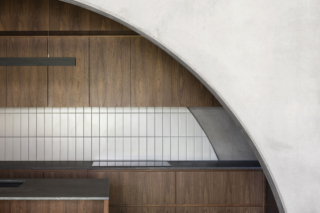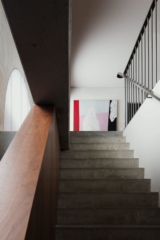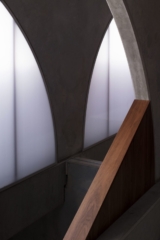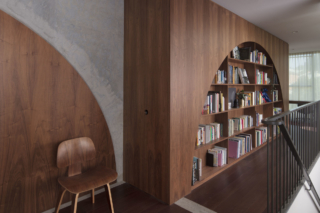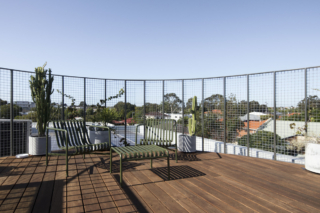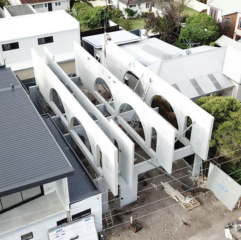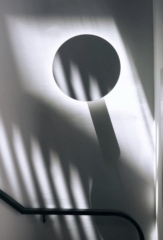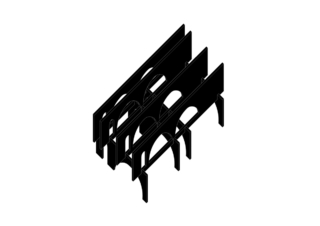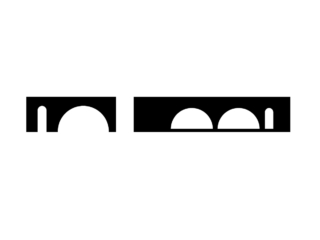The North Perth House is an urban-infill project in inner-city Perth.
Located on a small block, the design responds by providing a variety of spaces, determined by a simple structural arrangement.
Efficiencies of construction and economies of trade were key considerations in managing a tight budget and a difficult site with restricted access.
Concrete pre-cast panels are deployed to be both the finishing material and the building structure.
By using this commercial construction system as the main conceptual organising principle, the project was able to gain significant budget and time savings, while maintaining legible design integrity and innovation in housing type.
There are only two panel types in the project; one for the ground floor running east-west parallel to the street, and one for the first floor running north-south pointing to the city.
The four panels on the ground floor support the four on the first floor and interlock like a lattice, staying secured by gravity with some lateral bracing.
On the ground floor, these panels demarcate layers of privacy from the street front back towards the rear of the property, each signifying a threshold leading deeper into the private life of the house.
It unfolds; garage, gallery, vestibule, kitchen, then living and garden.
On the first floor, the panels rotate 90 degrees, giving long views back to Perth city on the south side and to welcome northern light into bedrooms.
Moments of overlap allow for interesting spatial dynamics and vertical and oblique views through and out of the house.
Each panel is punctuated with one of two types of arch, a grand arch, and a pedestrian arch.
The grand arch is provided for the more significant gestures in the house – prospect from the kitchen, a sun-shade to the rear, a hidden robe, and a gallery window.
The pedestrian arch is for clean perpendicular travel.
The pedestrian arch also maintains the length and width of the site.
On opening the front door, an uninterrupted sightline is presented from the front to the rear of the lot.
Similarly, on arriving on the first floor, the pedestrian arch presents the full width of the house.
These are important gestures on a constrained site of 9.5 x 23 metres.
When the arch is not required, it is filled in with a timber inlay or insulated translucent polycarbonate sheet, keeping the opening legible.
The material palette is deliberately restrained to these three treatments:
- raw concrete for the heavy and hard-working elements like the structural panels and the floor.
- timber for the intimate moments like furniture, kitchen joinery, balustrades and bedheads.
- translucent sheeting to mediate the hard east and west sun and provide soft light to the height of the interior spaces.
The simplicity of the design belies the complexity of the resulting spaces that are created; spaces that are compressed and dark, high and washed, raw and unfinished, and rich and intimate.
Architect Nic Brunsdon’s brief for this project was for a small inner-urban house that made the most of its site. The clients came with wonderful precedents, focusing on Japanese urban-infill houses.
They were set on a concrete house.
But initial investigations revealed that they wouldn’t be able to afford an in-situ concrete build.
So the move to pre-cast concrete panels was made, along with restricting the type and number of them.
The tight site and an inner-city build were challenging.
The pre-cast concrete construction methodology meant the builder could fabricate off-site and reduce the construction program.
That choice also restricted disruption to the street and allowed accelerated clean trade scheduling.
This project is unique in that there are only two panel types used and these are the conceptual framework for the spaces of this home.
The resultant spaces, although being conceived in restriction and limit, are incredibly varied and delightful.
Project Awards
- WA Architecture Award Best New House 2020
- WA Architecture Award Best Interior 2020
- Shortlist Australian Houses Awards Best House Under 200m2
Project Details
Project Size – 195 m2
Site Area – 230 m2
Completion Date – 2019
Building Levels – 2
Project Details
Architecture
Nic Brunsdon
Nic is the director of the design practice NIC BRUNSDON (formerly POST- architecture), and the director of the urban program Spacemarket, which pairs disused spaces with useful people.
His architecture studio is much awarded and operates locally and internationally from Perth, Western Australia.
Photography
Ben Hosking
Ben Hosking is an Architectural Photographer from Melbourne, Australia.
He studied photography at RMIT, and has worked as a freelancer in the field since 2008. His work has been published both locally and internationally by publishing houses such as Taschen, Gestalten, and Thames and Hudson.
Photo Gallery
Click on a thumbnail image to enlarge.
Design © 2020 Nic Brunsdon. All Rights Reserved.| Images © 2020 Ben Hosking. All Rights Reserved.
Get the Builtworks Letter
In every edition of the Builtworks Letter, you’ll get the behind-the-scenes backstory as to how buildings are designed, built, and brought to life.
You’ll hear compelling stories, learn surprising ideas, meet engaging characters, and discover unique voices.


